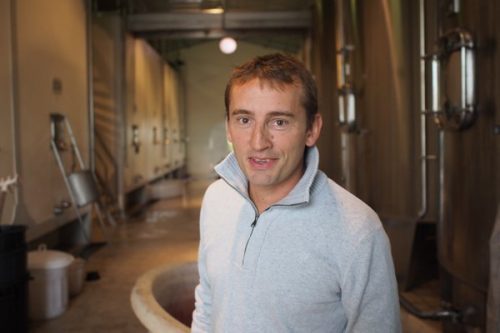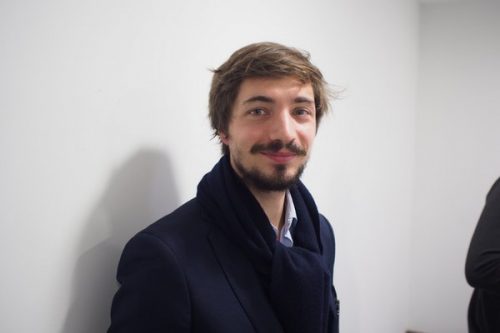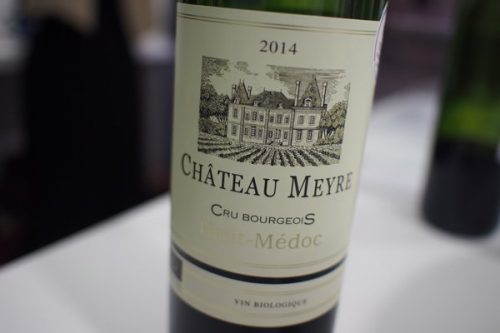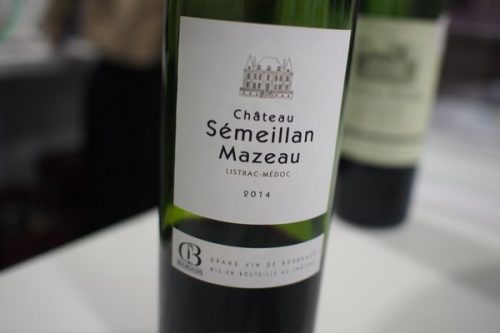
The Médoc is at the heart of Bordeaux. As well as the 60 Grand Cru Classé estates that sit at the top of the hierarchy of vineyards, there are another 280 estates that compete each year to be part of the Cru Bourgeois selection. In the next part of the Alternative Bordeaux series, we go to Château Labadie, which since 2008 has been selected for the Cru Bourgeois. We met here with young proprietor Jérôme Bibey, and also the people behind two further Cru Bourgeois properties, Maxime Juillot of Château Sémillan Mazeau, and Pierre-Alexandre Gazaille of Château Meyre. All three have been working with organics over the last few years.
Labadie has clay and limestone soils, as well as about 20% sandy soil with. The limestone in the Médoc is from the sea and the lagoon, and also from lakes, depending on where you are. Clay is found on top of the limestone. There is also a lot of Cabernet Sauvignon in the northern Médoc, and this has to be on the limestone because it ripens faster. ‘I’m trying to produce wine the right way,’ says Jerome. He doesn’t use pesticides, and just copper and sulfur for fungicides. ‘But it’s difficult to work the soil for 70 hectares, so I need to use some herbicide.’ He has a lot of clay soils, and these are hard to work. The trunk disease Esca is a bit problem. ‘I need to remove and replant 10-15% each year. The Cabernet is especially problematic. Since we started using only copper and sulphur, two years ago, it looks like we have less disease.’

Château Labadie 2014 Médoc, Bordeaux
55% Merlot, 40% Cabernet Sauvignon, 5% Cabernet Franc. Supple blackcurrant and blackberry fruit with nice stony, cedary complexity. Shows a touch of toast and spice from the oak. Nice elegance here with a smooth texture and a hint of chocolate. Supple and delicious drinking now. 90/100
Château Pontet Barrail 2014 Médoc, Bordeaux
This is Jerome’s grandfather’s property, but the wines are made here. 60% Cabernet Sauvignon, 30% Merlot and the balance Petit Verdot and Malbec. Comes from the oldest vines of the property. Quite dense and structured with sweet black fruits and some spice and cedar. Tannic but with attractive ripe fruit characters, too. Supple and attractive with a firm woody edge. Needs time to settle down. 89/100
Malbec de Labadie 2015 Médoc, Bordeaux
Vivid, sleek and intense with a floral edge to the nose. Very fresh and aromatic with nice vivid black cherry and raspberry fruit. Really pretty and expressive with lovely fruit expression and a bit of pepper on the finish. 91/100

Pierre-Alexandre Gazaille started at Meyre with organics in 2008, and the first certified vintage was 2011. It was the second cru Bourgeois to be certified as organic. Out of more than 250 chateau there are still only four organically certified,’ he says. ‘People are paying more attention so I hope there will be more. In 2008 when we started it was quite difficult. 11, 12 and 13 were quite low yielding vintages.’
‘Producing wine in the Médoc is quite stupid,’ says Pierre. ‘ We are between the Garonne and the Atlantic Ocean, and, as you know, the biggest enemy for the vineyard is humidity.’ But he adds, ‘it is not more difficult to be organic in Bordeaux than Champagne or the Loire Valley. Of course, if you compare organic agriculture in the north of Spain or south of France, it is a lot easier there.’ Pierre points out that the problem of organic treatments is that when you have the disease, it is too late, you don’t have a remedy.’ One of the problems with organics in the region is that the official advice about applying treatments, which work by contact, is that the intervals are determined by rainfall, which washes them off. ‘The thing we forget is that in June and July we have a lot of fog, and this also helps drain the compounds off. You can have no rain for three weeks but the humidity removes the copper so you need a new treatment.
Pierre also notes that in Bordeaux, many of the organic vineyards are on the right bank where the properties tend to be smaller. ‘In the Médoc we traditionally have bigger properties, with a lot of plants per hectare. It is more difficult to work these organically.’ The right bank averages 6 ha per property, while the left bank averages 30.

Château Meyre 2014 Haut Médoc, Bordeaux
44 Merlot, 40 Cabernet Sauvignon, 11 PV, 5% Cabernet Franc. Supple, spicy and direct with a savoury spicy edge to the fruit. Some cedar spice and a hint of mint. Has a juicy quality and some elegance, with a bit of grip on the finish. 89/100

Maxime Juillot’s Château Sémeillan Mazeau is based in the Listrac appellation from the south of Médoc. Soils are sands and gravels, with 10% clay limestone. In 2012 he started converting to organics, and from 2015 has been certified.
‘The ideal size [for an organic vineyard] is 10 ha,’ he says. ‘You can do this with one person, with 7000 plants/hectare. If you have 110 hectares, you need 11 people.’ Maxime adds, ‘One of the the problems is that the plants are not used to this kind of agriculture. It takes for the plants to get used to this agriculture.’

Château Sémeillan Mazeu 2014 Listrac-Médoc, Bordeaux
15% aged in barrels. Supple and fine with lovely texture and weight. Lovely elegant red fruits with some blackcurrant hints. Very supple and elegant with lovely purity and weight. Shows lovely elegance with nice balance to the fruit and fine-grained tannins. Such a lovely wine. 92/100
Pierre adds, ‘when you taste organic wines you will see that most of the time there is more freshness, because we work on the soils. You have lighter, fresher wines, probably more elegant.’ Maxime agrees: when you work the soils you drain the potassium, so the pH of the wines is lower. The wines are more acid.’
How does it affect yields? ‘When we started we lost yield,’ says Pierre. ‘After 2 years we got quite normal yields. Organic agriculture requires more tools and more people. For me you need 10 years.’
‘Everyone knows that organic wine is the future for the next generation,’ says Pierre. ‘The vineyard was planted 40 years ago, and I am just 28. I think about the vineyard for the next generation – the wine business is a very long-term business.’
Maxine adds, ‘let’s hope that in 10 years everyone will be organic.’
An interview with the three: